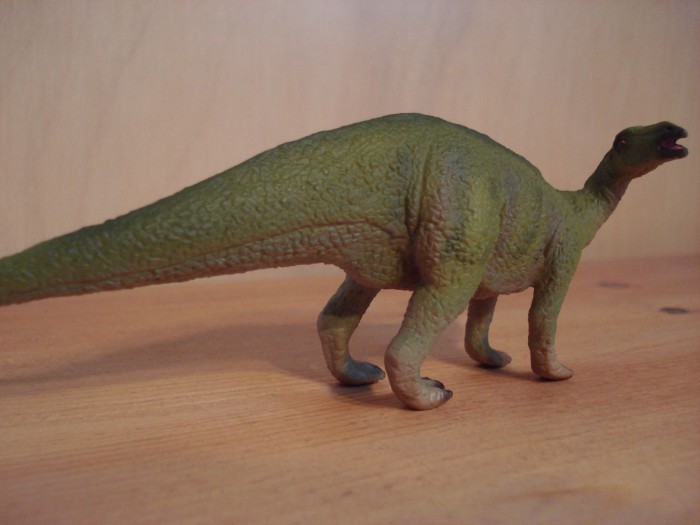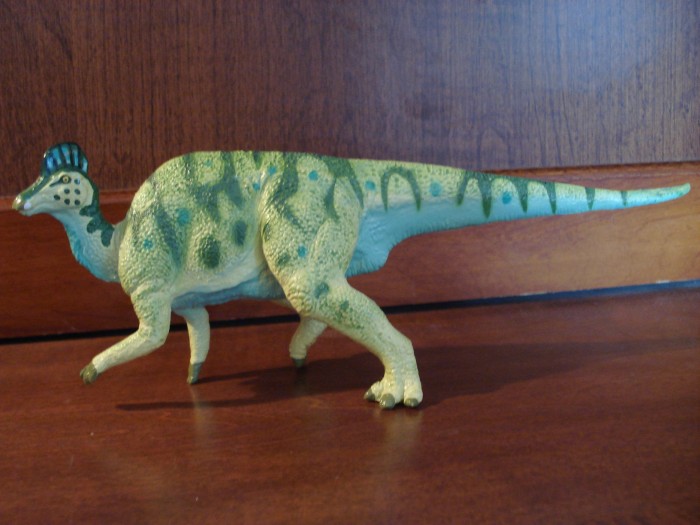Review and photos by Griffin
Tenontosaurus was an Iguanodontid ornithopod dinosaur that lived in the Western United States during the early Cretacious period. In life it would have co-existed with dinosaurs like Iguanodon, Dienonychus, Utahraptor and Acrocanthosaurus. Thanks to a Tenontosaurus skeleton discovered with Dienonychus chew marks on its bones in addition to Dienonychus skeletons nearby, the idea of pack-hunting Dromaeosaurs is now widely accepted. Unfortunately this has also lead to the image of poor Tenontosaurus to ALWAYS be the prey item for Deinonychus. (Seriously, google image search “Tenontosaurus”. Like 80% of the images that pop up will be of it being attacked and/or eaten by the Deinonychus.) Medullary bone tissue, which is used by modern birds for laying eggs, has also been found on the bones of Tenontosaurus fossils.
Author: Griffin
 Chris DiPiazza (aka Griffin8891) has worked with exotic animals for seven years now and has been a wildlife exhibitor, bringing live animals to camps and schools to educate children, for almost four years. In addition to living animals, he has an equally, if not stronger affinity for prehistoric ones as well. He also loves drawing, sculpting and painting and has recently illustrated a series of illustrations of dinosaurs to be used in lecture slides at Rutgers University in New Brunswick, NJ (which can be found under his thread in the art section of the forums). As far as dinosaur models go, he does not consider himself a true collector, but one who buys only what truly interests him. He loves all species of dinosaurs and other manner of prehistoric creatures but ultimately, he considers the Ceratopsians his favorites.
Chris DiPiazza (aka Griffin8891) has worked with exotic animals for seven years now and has been a wildlife exhibitor, bringing live animals to camps and schools to educate children, for almost four years. In addition to living animals, he has an equally, if not stronger affinity for prehistoric ones as well. He also loves drawing, sculpting and painting and has recently illustrated a series of illustrations of dinosaurs to be used in lecture slides at Rutgers University in New Brunswick, NJ (which can be found under his thread in the art section of the forums). As far as dinosaur models go, he does not consider himself a true collector, but one who buys only what truly interests him. He loves all species of dinosaurs and other manner of prehistoric creatures but ultimately, he considers the Ceratopsians his favorites.All reviews by this author
Review: Iguanodon (Carnegie Collection by Safari Ltd)
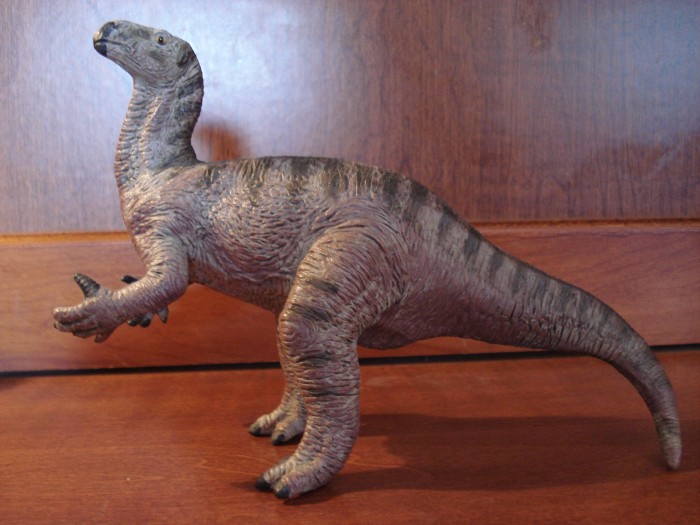
4 (15 votes)
Iguanodon was the second dinosaur ever to be recognized by science. The first fossils of the animal were teeth unearthed in England in 1822. Since then this iconic dinosaur’s image has undergone numerous changes throughout history as more discoveries are made about it. Iguanodon belongs to the extremely large and successful group of dinosaurs called the ornithopods which also encompasses the smaller hypsilophodonts as well as the later hadrosaurs.
Review: Lycaenops (Jurassic Park, Series 2 by Kenner)
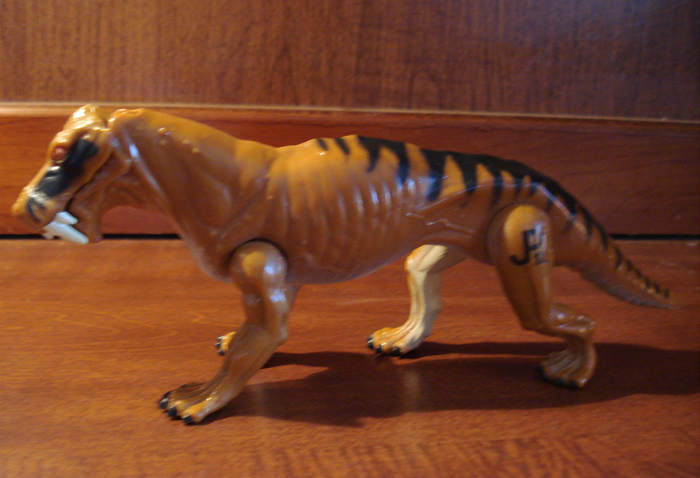
3.3 (9 votes)
Review and Photos by Griffin
Lycaenops was a three foot long mammal-like reptile, or Therapsid from Southern Africa during the Late Permian. It’s a distant later relative of the much more famous sail-backed, Dimetrodon. Its name means “Wolf Face” rightfully so due to its canine-like fangs on its upper and lower jaws.
Lycaenops was a three foot long mammal-like reptile, or Therapsid from Southern Africa during the Late Permian. It’s a distant later relative of the much more famous sail-backed, Dimetrodon. Its name means “Wolf Face” rightfully so due to its canine-like fangs on its upper and lower jaws.
Review: Pachycephalosaurus (Jurassic Park, Series 2, by Kenner)

3.3 (12 votes)
Following up on the Pachycephalosaurus theme started in the last blog entry, here’s a review of a quite different version of this dome-headed dinosaur. Both the review and photos are by Griffin8891
Now before we all start pelting poor Jurassic park toys with “that’s inaccurate!” and “not scientific!” let’s make one thing very clear.
Now before we all start pelting poor Jurassic park toys with “that’s inaccurate!” and “not scientific!” let’s make one thing very clear.
Review: Pachycephalosaurus (Carnegie Collection by Safari Ltd)
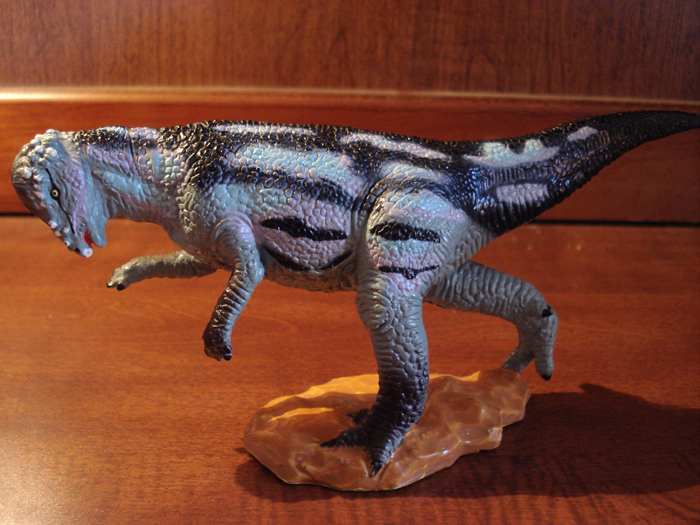
4 (14 votes)
Pachycephalosaurus belongs to the general group of dinosaurs called marginocephalia which encompasses all the dome-headed pachycephalosaurs as well as all of the ceratopsians. Pachycephalosaurus itself was the largest of the dome headed dinosaurs, estimated to have grown to between fifteen or perhaps twenty feet in length.
Review: Leptoceratops (Wild Safari by Safari Ltd)
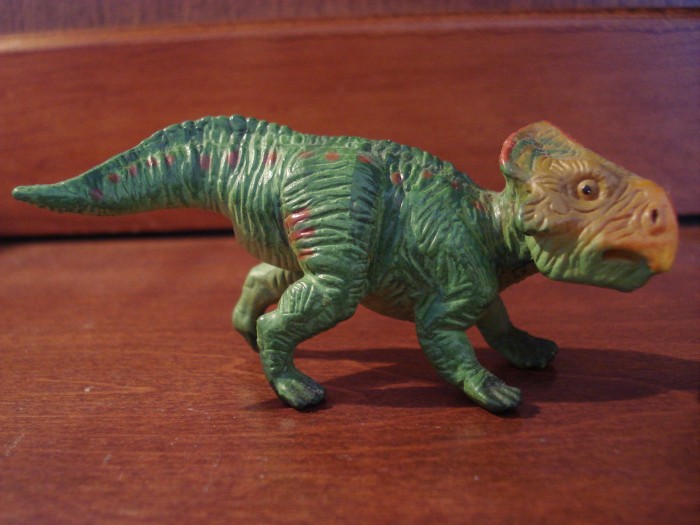
3.9 (11 votes)
Leptoceratops was a small ceratopsian from the Maastrichtian period at the very end of the Cretacious in North America. It would have lived alongside it’s much more famous cousins, Triceratops and Torosaurus as well as other dinosaurs like Tyrannosaurus, Pachycephalosaurus and Anatotitan to name a few.
Review: Psittacosaurus (Carnegie Collection by Safari Ltd)
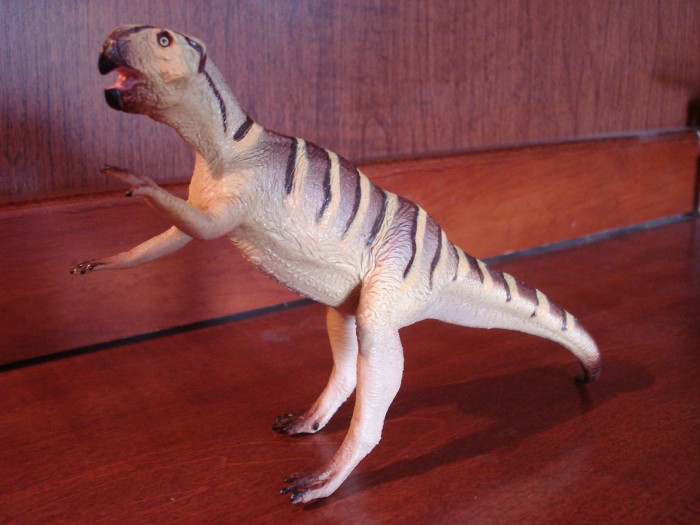
4 (10 votes)
Psittacosaurus, the “parrot lizard” is a very early member of the broad dinosaur group Marginocephothelia which includes the horned dinosaurs such as Triceratops and also the distantly related dome-headed dinosaurs such as Pachycephalosaurus. It lived in Asia during the early Cretacious about 130 million years ago and was relatively small for a dinosaur, only about 6 feet in length.

